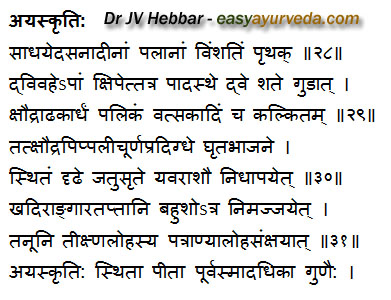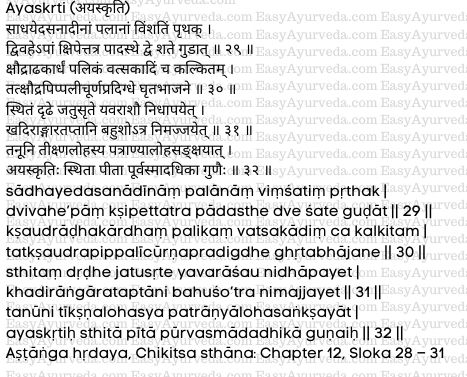Ayaskriti is a liquid Ayurvedic medicine. It is mainly used in anemia, weight loss therapy, skin diseases etc. It is more commonly used in South Indian Ayurveda practice. It contains iron as an ingredient. The word Ayas in sanskrit means Iron.
Table of Contents
ToggleDose
12 – 24 ml. one or two times a day, usually advised after food.
With western medicines
Seek your doctor’s advice if you are taking this product along with other western (allopathic/modern) medicines. Some Ayurvedic herbs can interact with modern medicine.
If both Ayurvedic and allopathic medicines are advised together, then it is best to take allopathic medicine first, wait for 30 minutes and then, after a gap of 15 – 30 minutes, take Ayurvedic medicine or as directed by the physician.
Can this be used while taking Homeopathic medicine?
Yes. This product does not react with homeopathic medicine.
With supplements like multivitamin tablets, Omega 3 fatty acids etc?
Yes. Generally, this product goes well with most of the dietary supplements. However, if you are taking more than one product per day, please consult your doctor for an opinion.
Adjuvants:
Mehashmari vati, Brihnmehantakam gulika, Niruryadi vati, Abhra bhasmam, Loha bhasmam and Svarna bhasmam to suit the ailment.
Watch Video
Pathya:
In diabetes- Avoid sweets like milk and ghee. Sugar is totally taboo. Reduce sour and salty items. For meals use old barley and wheat. Rice is not very good. Rice from fresh paddy is harmful. Do physical exercise in an open place according to strength.
Uses
Ayaskriti is used in the Ayurvedic treatment of
Chronic urinary tract disorders, diabetes – Meha
Hemorrhoids – Arsha
Leukoderma – Shwitra
Skin disorders – Kushta
Anorexia – Aruchi
Intestinal worm – Krumi
Anemia – Pandu
Malabsorption disorder, IBS – Grahani
Obesity – Grahani
Purifies the fat and reduces obesity. The precipitates in the urine and other troubles due to diabetes are controlled, if taken daily. also good to prevent formation of abscesses.
Ayaskruti for ascites:
For Kaphaja type of ascites, associated with symptoms – Heaviness, anorexia, cough, cold, indigestion, malaise, numbness, nausea etc, Ayaskriti is administered after Vamana treatment. (Charaka Samhita Chikitsa Sthana 13th chapter).
How long to use?
Based on doctor’s prescription, this medicine can be used for several months.
Safe for kids?
Safe in lower doses for kids above 3 years of age. Accidental over-dosage should be strictly avoided.
Pregnancy and lactation:
Best to avoid during pregnancy. Can be taken during lactation period, after consulting doctor.
Side effects
Large dose of Ayaskriti, or taking Ayaskriti before food on empty stomach may cause stomach irritation and stomach upset.
Caution: Ayaskriti should always be taken only under medical supervision. Since Ayaskriti contains iron, accidental overdose in children may be fatal.
Reference
Its reference is found in Ashtanga hrudaya chikitsasthana 12/28- 31.
Ingredients
Asana (Pterocarpus marsupium) – Heart wood – 960 g
Tinisha (Lagerstroemia speciosa) – Heart wood – 960 g
Bhurja (Betula utilis) – Stem bark – 960 g
Arjuna (Terminalia arjuna) – Stem bark – 960 g
Prakirya – Latakaranja (Caesalpinia crista) – seed – 960 g
Khadira (Acacia catechu) – Heart wood – 960 g
Shvetakhadira – Kadara – Heart wood – 960 g
Bhandi – Shirisha ( Albizia lebbeck) – Stem bark – 960 g
Shimshapa (Dalbergia sissoo) – Heart wood – 960 g
Meshashrungi (Prosopis specigera) – Leaf – 960 g
Peeta chandana, Rakta chandana (Pterocarpus santalinus) – Heart wood – 960 g
Shweta chandana (Santalum album) – Heart wood – 960 g
Tala (Borassus flabellifera) – Flower – 960 g
Palasha (Butea monosperma) – Seed – 960 g
Jongaka – Agaru ( Aquilaria agallocha) – Heart wood – 960 g
Shaka – Heart wood – 960 g
Shaala (Shorea robusta) – Heart wood – 960 g
Kramuka (Arecanut) – Seed – 960 g
Dhava (Anogeissus latifolia) – Stem bark- 960 g
Kalinga – Indrayava (Holarrhena antidysenterica) – seed – 960 g
Chagakarna – Ajakarna (Acacia leucophloea) – Heart wood – 960 g
Ashwakarna (Acacia leucophloea) – Heart wood – 960 g
Water for decoction – 98.304 liters
Boiled and reduced to 24.576 liters
Guda – Jaggery – 9.6 kg
Kshaudra – Honey – 1.536 kg
Vatsaka – Kutaja – Holarrhena antidysenterica – Stem bark – 48 g
Murva (Marsdenia tenacissima) – Root – 48 g
Bharngi (Clerodendron serratum) – Root – 48 g
Katuka (Picrorrhiza kurroa) – Rhizome – 48 g
Black pepper – Fruit – 48 g
Ghunapriya – Ativisha (Aconitum heterophylum) – Root – 48 g
Gandira – Coleus Forskohlii – 48 g
Snuhi (Euphorbia neriifolia) –
Ela – Cardamom – 48 g
Patha (Cyclea peltata) – Root – 48 g
Jeera – Cumin (Cuminum cyminum) – Fruit – 48 g
Katvanga (Orchis mascula) – Stem bark – 48 g
Ajamoda – Ajowan – Fruit – 48 g
Siddharta Mustard – – 48 g
Vacha (Acorus calamus) – Rhizome – 48 g
Hingu – Asa foetida – 48 g
Vidanga (Embelia ribes) – Fruit – 48 g
Long pepper and long pepper root
Pashugandha – Ajagandha – Cleome gynandra / viscosa Linn. / Gynandropsis gynandra Root – 48 g
chavya (Piper retrofractum) – Stem – 48 g
Chitraka (Plumbago zeylanica) – Root – 48 g
Shunti – Ginger – Rhizome – 48 g
Teekshna Loha Patra – Iron leaf – 768 g
Pippali Churna – Long pepper fruit powder – quantity sufficient
Kshaudra – honey – quantity sufficient
Ghrita – Ghee – quantity sufficient
Laksha – Laccifer lacca – resin – quantity sufficient.
Method of manufacturing:
Decoction of Asanadi Gana (first set of herbs) is prepared. Filtered. Jaggery is added to the decoction, Filtered. Honey is added.
Kalka (paste) made of Vatsakadi gana (group of herbs) is prepared, added to the decoction and poured into a pot that is previously smeared with ghee, honey and long pepper powder. The pot is given an outside coating with Laksha. It is placed in a heap of barley.
Thin sheets of Iron are heated to red hot by using Khadira (Acacia catechu) as fuel and dipped into the decoction. This process is repeated several times till the iron is powdered completely and gets mixed with the decoction. The mouth of the pot is sealed air tight till the fermentation completes. After fermentation is completed, the contents are filtered to get Ayaskriti.
Shloka- Sanskrit verse


Sanskrit verse from traditional book having product description:
Expiry date: 10 years from the date of manufacture.
Storage: Store in a cool place in tightly closed amber coloured bottle, protect from light and moisture.
Please consult your doctor before taking this medicine.
This article is written by Dr. Janardhana V Hebbar BAMS, MD (Ayu), PGDPSM, Managing Director, Easy Ayurveda Hospital.
It is reviewed by Dr. Raviganesh Mogra BAMS, MD (Ayu), Chief Medical Officer, Easy Ayurveda Hospital









17 thoughts on “Ayaskriti Uses, Dose, Side Effects And Ingredients”
THIS IS ADVISED BY MY DOC. FOR OBISITY ? BUT IT USES AS GIVEN ABOVE DIFFERS. ANY COMMENT ?
Hi, It is also used in the treatment of obesity.
For obesity kindly do Yoga only especially Kapalbharti & Analom Vilom Prayanama. No medicine can make you lose weight as quickly as yoga but before that there shouldn’t be any constipation present..
What is shelf life for yograj guggul?
Yograj Guggulu – 5 years from the date of manufacturing.
Sir, who are the major manufacturers for this medicine ?
Can ayushkriti be given to a diabetic patient who also has skin allergy? Sugar level is 250.
No, because the sugar level is too high (assuming it is fasting blood sugar level)
sir,is this to be taken under medical supervision for obesity?
Dear Dr. Hebbar,
I have been recommended Varadi Kashayam by Kottakkal doctors to help lose weight. May I use Ayaskriti Rasayanam (which I have recently come to know through your website) in conjunction with Varadi Kashayam? Are there any contraindications? Else, does having Ayaskriti speed-up the weight loss process?
Just as context, I am 34, Male, weighing 114 kgs, and am also currently practicing yoga / other weight loss exercises, in addition to having Varadi Kashayam everyday morning and night.
Thanks a lot for your guidance.
RDN
just came across your comment. did varadi kashayam help you lose weight? i am going to be starting it next week. so just wanted to know if it was effective to you.
sir, please advice this can be taken along with depression tablets
If fasting blood sugar is below 130, then you can use it thrice. or else, twice is better, as per my knowledge.
Thank you. My fasting sugar reading is 190. I will take twice
Sir is ayuskirti
helpful to control diabetic
Only in mild rise in sugar levels, it is effective.
Can this medicine useful to treat chronic Pancreatitis?